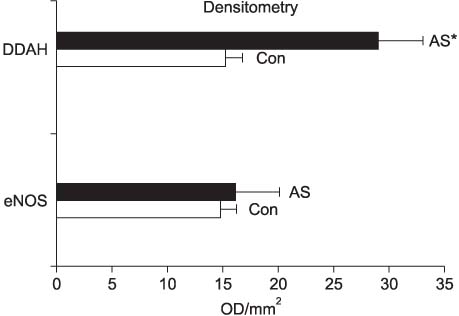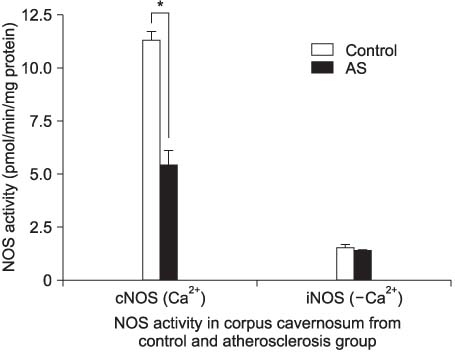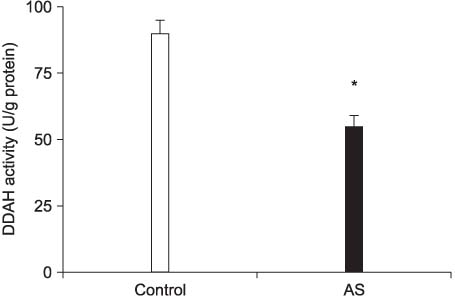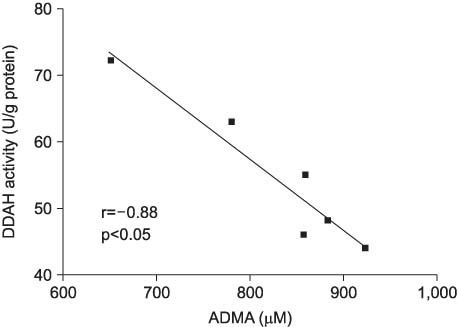Korean J Urol.
2006 Oct;47(10):1079-1085. 10.4111/kju.2006.47.10.1079.
Dysregulation of Dimethylarginine Dimethylaminohydrolase Causes Elevation of Asymmetric Dimethylarginine in a Rat Model of Vasculogenic Erectile Dysfunction
- Affiliations
-
- 1Department of Urology, Seoul National University College of Medicine, Seoul, Korea. jspaick@snu.ac.kr
- 2Department of Urology, Korea Cancer Center Hospital, Seoul, Korea.
- KMID: 2139809
- DOI: http://doi.org/10.4111/kju.2006.47.10.1079
Abstract
-
PURPOSE: Asymmetrical dimethylarginine (ADMA) is an endogenous inhibitor of nitric oxide synthase (NOS) and the major metabolic pathway of ADMA is enzymatic degradation via dimethylarginine dimethylaminohydrolasease (DDAH). In this study, we hypothesized that an elevated cavernosal ADMA level might result from poor DDAH activity in the corpus cavernosum. We examined whether ADMA was accumulated in our atherosclerotic rat model of vasculogenic erectile dysfunction (VED).
MATERIALS AND METHODS
Twelve 12-wk-old Sprague-Dawley rats were grouped in either the atherosclerosis group (AS, n=6) or the control (n=6) group. The AS group received a 1% cholesterol diet for 6 weeks and the rats were also treated with NG-nitro-L-arginine methyl ester (3mg/ml) for the initial 2 weeks. The control group received a normal diet. Six weeks later, all the rats were anesthetized with urethane (1.6g/kg) and cavernous electrostimulation was done under continuous arterial and cavernosal pressure monitoring (6V, 0.5ms, 20Hz, 50sec). The methylarginine level in both the AS group and the control group was measured respectively. Also, the NOS activity and DDAH activity in the corpus cavernosum were evaluated.
RESULTS
Upon cavernous electostimulation, the peak intracavernosal pressure (ICP) of the control group was 88.5+/-5.5mmHg (n=6). In contrast, the peak ICP level was markedly reduced in the atherosclerotic group to 54.2+/-4.8mmHg (n=6, p<0.001). The cavernosal level of ADMA in the control group was 320.5+/-23.6micrometer and it was 860.7+/-34.7micrometer in the AS group. The constitutive NOS activity in the rat corpus cavernosum of the AS group was markedly reduced compared to the control group. Also, the cavernosal DDAH activity was reduced in the AS rats and the activity showed significant negative correlation with the cavernosal ADMA level.
CONCLUSIONS
In this study, we have demonstrated that the dysregulation of DDAH activity may be one of the causes of decreased NOS activity in atherosclerotic erectile dysfunction.
Keyword
MeSH Terms
Figure
Reference
-
1. Son HC, Byun SS, Park EC, Cho KS, Jo MK, Kim SW, et al. Prevalence of sexual dysfunction in men older than 40 living in Seoul: epidemiologic survey using questionnaire. Korean J Urol. 2002. 43:52–61.2. Feldman HA, Goldstein I, Hatzichristou DG, Krane RJ, McKinlay JB. Impotence and its medical and psychosocial correlates: results of the Massachusetts Male Aging Study. J Urol. 1994. 151:54–61.3. Krane RJ, Goldstein I, Saenz de Tejada I. Impotence. N Engl J Med. 1989. 321:1648–1659.4. Junemann KP, Persson-Junemann C, Alken P. Pathophysiology of erectile dysfunction. Semin Urol. 1990. 8:80–93.5. Vardi Y, Siroky MB. Hemodynamics of pelvic nerve induced erection in a canine model. I. Pressure and flow. J Urol. 1990. 144:794–797.6. Vardi Y, Siroky MB. Hemodynamics of pelvic nerve induced erection in a canine model. II. Cavernosal inflow and occlusion. J Urol. 1993. 149:910–914.7. Jones RW, Rees RW, Minhas S, Ralph D, Persad RA, Jeremy JY. Oxygen free radicals and the penis. Expert Opin Pharmacother. 2002. 3:889–897.8. Leiper J, Vallance P. Biological significance of endogenous methylarginines that inhibit nitric oxide synthases. Cardiovasc Res. 1999. 43:542–548.9. Cooke JP. Does ADMA cause endothelial dysfunction? Arterioscler Thromb Vasc Biol. 2000. 20:2032–2037.10. Das I, Khan NS, Puri BK, Hirsch SR. Elevated endogenous nitric oxide synthase inhibitor in schizophrenic plasma may reflect abnormalities in brain nitric oxide production. Neurosci Lett. 1996. 215:209–211.11. Boger RH, Bode-Boger SM, Szuba A, Tsao PS, Chan JR, Tangphao O, et al. Asymmetric dimethylarginine (ADMA): a novel risk factor for endothelial dysfunction: its role in hypercholesterolemia. Circulation. 1998. 98:1842–1847.12. Masuda H, Goto M, Tamaoki S, Azuma H. Accelerated intimal hyperplasia and increased endogenous inhibitors for NO synthesis in rabbits with alloxan-induced hyperglycaemia. Br J Pharmacol. 1999. 126:211–218.13. MacAllister RJ, Vallance P. Nitric oxide in essential and renal hypertension. J Am Soc Nephrol. 1994. 5:1057–1065.14. Tran CT, Leiper JM, Vallance P. The DDAH/ADMA/NOS pathway. Atheroscler. 2003. 4:Suppl. 33–40.15. Park K, Son H, Kim SW, Paick JS. Initial validation of a novel rat model of vasculogenic erectile dysfunction with generalized atherosclerosis. Int J Impot Res. 2005. 17:424–430.16. Shin JW, Park K, Kim SW, Paick JS. Putative asymmetric dimethylarginine - dimethylarginine dimethylaminohydrolase pathway in rat penile tissue: a biochemical and functional study. Korean J Androl. 2004. 22:124–131.17. Azuma H, Masuda H, Sato J, Niwa K, Tokoro T. A possible role of endogenous inhibitor for nitric oxide synthesis in the bovine ciliary muscle. Exp Eye Res. 1997. 64:823–830.18. NIH. Consensus development conference statement. National Institutes of Health Impotence. December 7-9. 1992. Int J Impot Res. 1993. 5:181–284.19. Rance J, Phillips C, Davies S, O'Malley B, Zaman Q, Price D. How much of a priority is treating erectile dysfunction? A study of patients' perceptions. Diabet Med. 2003. 20:205–209.20. Siroky MB, Azadzoi KM. Vasculogenic erectile dysfunction: newer therapeutic strategies. J Urol. 2003. 170:S24–S29.21. Andersson KE. Erectile physiological and pathophysiological pathways involved in erectile dysfunction. J Urol. 2003. 170:S6–S13.22. Solomon H, Man JW, Jackson G. Erectile dysfunction and the cardiovascular patient: endothelial dysfunction is the common denominator. Heart. 2003. 89:251–253.23. Feldman HA, Goldstein I, Hatzichristou DG, Krane RJ, McKinlay JB. Construction of a surrogate variable for impotence in the Massachusetts Male Aging Study. J Clin Epidemiol. 1994. 47:457–467.24. Matsuoka H. Endothelial dysfunction associated with oxidative stress in human. Diabetes Res Clin Pract. 2001. 54:Suppl. S65–S72.25. Oemar BS, Tschudi MR, Godoy N, Brovkovich V, Malinski T, Luscher TF. Reduced endothelial nitric oxide synthase expression and production in human atherosclerosis. Circulation. 1998. 97:2494–2498.26. Ayajiki K, Hayashida H, Okamura T, Toda N. Pelvic nerve stimulation-induced pressor responses in corpus cavernosum of anesthetized dogs. Am J Physiol. 1997. 273:H2141–H2145.27. Masuda H, Tsujii T, Okuno T, Kihara K, Goto M, Azuma H. Accumulated endogenous NOS inhibitors, decreased NOS activity, and impaired cavernosal relaxation with ischemia. Am J Physiol Regul Integr Comp Physiol. 2002. 282:R1730–R1738.28. MacAllister RJ, Parry H, Kimoto M, Ogawa T, Russell RJ, Hodson H, et al. Regulation of nitric oxide synthesis by dimethylarginine dimethylaminohydrolase. Br J Pharmacol. 1996. 119:1533–1540.29. Achan V, Tran CT, Arrigoni F, Whitley GS, Leiper JM, Vallance P. All-trans-Retinoic acid increases nitric oxide synthesis by endothelial cells: a role for the induction of dimethylarginine dimethylaminohydrolase. Circ Res. 2002. 90:764–769.
- Full Text Links
- Actions
-
Cited
- CITED
-
- Close
- Share
- Similar articles
-
- Putative Asymmetric Dimethyl Arginine-Dimethylarginine Dimethylaminohydrolase Pathway in Rat Penile Tissue: A Biochemical and Functional Study
- Combination of Gene Therapy with Antioxidant Therapy in a Rat Model of Vasculogenic Erectile Dysfunction
- Investigation of symmetric Clinical Pathology dimethylarginine as a serologic marker for kidney function in striped skunks (Mephitis mephitis)
- Evaluation of Asymmetric Dimethylarginine, Malondialdehyde, and Vitamin Levels of Borderline Personality Disorder Patients With and Without Self-Mutilation
- The Association Between Asymmetric Dimethylarginine (ADMA) and Vasospastic Angina, Hypertension, and Cardiovascular Risk Factors






